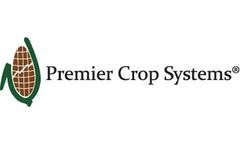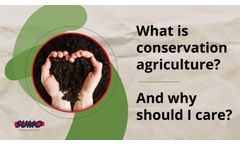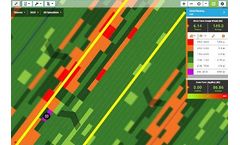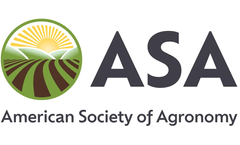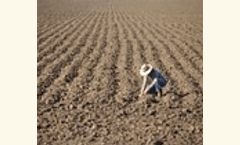Tillage Practices Articles & Analysis: Older
33 articles found
Monitoring soil health is essential for farmers to make informed decisions about crop management practices, fertilizer application, and irrigation strategies. In recent years, advanced soil sensor systems have revolutionized the way we monitor and assess soil health parameters. ...
ByJXCT
Everyone knows the environmental impact carbon emissions have on the environment, speeding up climate change and causing extreme weather conditions. However, fewer people are aware of the importance of using water conservatively, as resources are quickly diminishing across the world, which not only exacerbates climate change, but could also put human and animal life at ...
In my area of Iowa, primarily in Mitchell County, the adoption of strip-till has been huge. There were three or four people that started in the early 2000s, along with my dad, that were pretty vocal about what they were seeing and what kind of benefits they were getting from reducing tillage and going to a strip-till pass. I would love everybody to switch to strip-till and then to no-till down ...
With the uncertainty of ELM’s, governmental policy, the goal of net zero and other market pressures, farmers are being encouraged to adopt sustainable practices. Such practices include: Minimum or zero tillage Cover cropping Crop rotation Reduced fertiliser and chemical use Traditional tillage methods and chemical ...
It is no secret that ground conditions and tillage practices present different challenges for growers during planting season. Those who practice no-till with cover crops can have the most difficult environments for planters when it comes to seed placement - specifically seed depth. Time and again our TechTrials reveal that no matter the farming ...
Like any business, farmers must manage their farms with one foot in the present and the other in the future. It’s not enough to focus just on yields. We must also consider the impact those yields have on our fields. To ensure sustainable crop production, the implementation of a method like conservation tillage is vital. Conservation tillage is a tilling process that leaves at least ...
ByGrowers
While the optimum depth for corn is generally universal no matter where you are located, your ground and farming practices can make a big difference in what you need to do to achieve that depth – especially tillage practices. So we set out to answer – How does SureForce perform compared to springs in a no till environment and a ...
It involves leaving the previous year's crop residue (such as corn stalks) on the ground when planting the next crop, with little or no mechanical tillage. The practice is used globally on over 370 million acres, mostly in South America, Oceania and North America. ...
The objectives of the current study were to 1) determine the best tillage practice (conventional versus conservation tillage) in terms of grain yields and potential environmental risk, 2) assess insecticidal exposure using concentrations measured in soil and runoff water and sediments, 3) compare measured insecticidal concentrations to predicted ...
A three-season research study was conducted at Embu Agricultural Research Station farm to determine the effect of glyphosate-based herbicides on weeds management and maize ( Zea mays L. ) performance under zero-tillage conservation agriculture practice. Glyphosate herbicide sprays were prepared from Roundup Turbo product at the rate of 2.5 L ha –1 and ...
Land application of animal manures such as poultry litter is a common practice, especially in states with surplus manure. Past studies have shown that animal manure may contain estrogens, which are classified as endocrine-disrupting chemicals and may pose a threat to aquatic and wildlife species. ...
Conservation tillage, besides being more economical, prevents soil erosion and has other beneficial effects on our environment, but few studies have been conducted on differential responses of different crops to conservation tillage. ...
This decline is in agreement with numerous long-term baseline data sets from chemical-based cropping systems involving a wide variety of soils, geographic regions, and tillage practices. The loss of organic N decreases soil productivity and the agronomic efficiency (kg grain kg–1 N) of fertilizer N and has been implicated in widespread reports of yield stagnation ...
Adoption of reduced tillage practices have been driven by the need to enhance soil quality, minimize field labor time, and scale up farm size. However, concerns about increased reliance on herbicides and demand for organically grown foods call for adoption of production practices that can reduce both tillage and herbicide use. ...
The use of crop rotation systems involving winter-annual grazing can help peanut (Arachis hypogaea L.) producers increase profitability, although winter-annual grazing could result in excessive soil compaction, which can severely limit yields. We conducted a 3-yr field study on a Dothan loamy sand in southeastern Alabama to develop a conservation tillage system for integrating peanut with ...
Broomrape (Orobanche crenata Forsk.) causes considerable losses in faba-bean (Vicia faba L.) production in the Mediterranean region. The application of an ultra-low glyphosate rate at an early broomrape parasitic phase, i.e., tubercle development, is the most common control system. This study sought to determine the effect of tillage system and glyphosate application on broomrape infestation, ...
As economic conditions deteriorated, cotton (Gossypium hirsutum L.) producers have looked to improve profit margins by reducing inputs while maintaining yields. Pairing the yield benefits from early planting with the input reductions from conservation tillage might help accomplish those goals. The objective was to determine how growth, lint yield, and fiber quality were impacted by planting ...
Nitrogen mineralization occurring near the soil surface of agroecosystems determines the quantity of plant-available N, and soil enzymes produced by microorganisms play significant roles in the N mineralization process. Tillage systems may influence soil microbial communities and N mineralization enzymes through alterations in total soil C and N. Soil aggregates of different sizes provide diverse ...
Escalating fossil fuel cost and concern over global climate change have accelerated interest in cellulosic feedstocks, such as corn (Zea mays L.) cobs, for liquid fuel production. Little information is available about this plant organ. We compiled and summarized available cob data from several recent field studies in the Central Great Plains. Data were collected from two locations in Colorado and ...
Both tillage and fertilizer management influence soil organic C (SOC) storage, but their interactive effects remain to be determined for various soil and climatic conditions. ...


